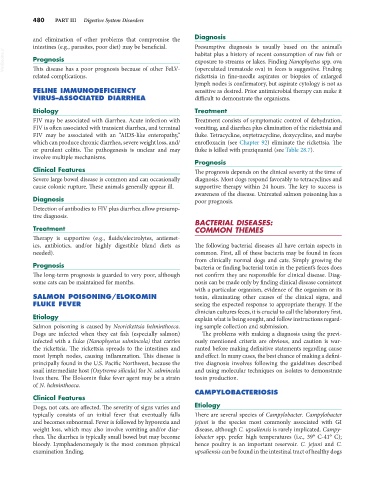Page 508 - Small Animal Internal Medicine, 6th Edition
P. 508
480 PART III Digestive System Disorders
and elimination of other problems that compromise the Diagnosis
intestines (e.g., parasites, poor diet) may be beneficial. Presumptive diagnosis is usually based on the animal’s
VetBooks.ir Prognosis exposure to streams or lakes. Finding Nanophyetus spp. ova
habitat plus a history of recent consumption of raw fish or
(operculated trematode ova) in feces is suggestive. Finding
This disease has a poor prognosis because of other FeLV-
related complications. rickettsia in fine-needle aspirates or biopsies of enlarged
lymph nodes is confirmatory, but aspirate cytology is not as
FELINE IMMUNODEFICIENCY sensitive as desired. Prior antimicrobial therapy can make it
VIRUS–ASSOCIATED DIARRHEA difficult to demonstrate the organisms.
Etiology Treatment
FIV may be associated with diarrhea. Acute infection with Treatment consists of symptomatic control of dehydration,
FIV is often associated with transient diarrhea, and terminal vomiting, and diarrhea plus elimination of the rickettsia and
FIV may be associated with an “AIDS-like enteropathy,” fluke. Tetracycline, oxytetracycline, doxycycline, and maybe
which can produce chronic diarrhea, severe weight loss, and/ enrofloxacin (see Chapter 92) eliminate the rickettsia. The
or purulent colitis. The pathogenesis is unclear and may fluke is killed with praziquantel (see Table 28.7).
involve multiple mechanisms.
Prognosis
Clinical Features The prognosis depends on the clinical severity at the time of
Severe large bowel disease is common and can occasionally diagnosis. Most dogs respond favorably to tetracyclines and
cause colonic rupture. These animals generally appear ill. supportive therapy within 24 hours. The key to success is
awareness of the disease. Untreated salmon poisoning has a
Diagnosis poor prognosis.
Detection of antibodies to FIV plus diarrhea allow presump-
tive diagnosis.
BACTERIAL DISEASES:
Treatment COMMON THEMES
Therapy is supportive (e.g., fluids/electrolytes, antiemet-
ics, antibiotics, and/or highly digestible bland diets as The following bacterial diseases all have certain aspects in
needed). common. First, all of these bacteria may be found in feces
from clinically normal dogs and cats. Simply growing the
Prognosis bacteria or finding bacterial toxin in the patient’s feces does
The long-term prognosis is guarded to very poor, although not confirm they are responsible for clinical disease. Diag-
some cats can be maintained for months. nosis can be made only by finding clinical disease consistent
with a particular organism, evidence of the organism or its
SALMON POISONING/ELOKOMIN toxin, eliminating other causes of the clinical signs, and
FLUKE FEVER seeing the expected response to appropriate therapy. If the
clinician cultures feces, it is crucial to call the laboratory first,
Etiology explain what is being sought, and follow instructions regard-
Salmon poisoning is caused by Neorickettsia helminthoeca. ing sample collection and submission.
Dogs are infected when they eat fish (especially salmon) The problems with making a diagnosis using the previ-
infected with a fluke (Nanophyetus salmincola) that carries ously mentioned criteria are obvious, and caution is war-
the rickettsia. The rickettsia spreads to the intestines and ranted before making definitive statements regarding cause
most lymph nodes, causing inflammation. This disease is and effect. In many cases, the best chance of making a defini-
principally found in the U.S. Pacific Northwest, because the tive diagnosis involves following the guidelines described
snail intermediate host (Oxytrema silicula) for N. salmincola and using molecular techniques on isolates to demonstrate
lives there. The Elokomin fluke fever agent may be a strain toxin production.
of N. helminthoeca.
CAMPYLOBACTERIOSIS
Clinical Features
Dogs, not cats, are affected. The severity of signs varies and Etiology
typically consists of an initial fever that eventually falls There are several species of Campylobacter. Campylobacter
and becomes subnormal. Fever is followed by hyporexia and jejuni is the species most commonly associated with GI
weight loss, which may also involve vomiting and/or diar- disease, although C. upsaliensis is rarely implicated. Campy-
rhea. The diarrhea is typically small bowel but may become lobacter spp. prefer high temperatures (i.e., 39° C-41° C);
bloody. Lymphadenomegaly is the most common physical hence poultry is an important reservoir. C. jejuni and C.
examination finding. upsaliensis can be found in the intestinal tract of healthy dogs

